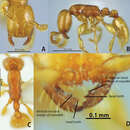en
names in breadcrumbs


Aenictus Shuckard, 1840: 266.
Typhlatta Smith, 1857: 79 (synonym of Aenictus by Forel, 1890: ciii; removed from synonymy as subgenus of Aenictus by Wheeler,1930: 198; synonym of Aenictus by Wilson, 1964: 444).
Diagnosis. Workers of Aenictus may be separated from other Australian ants by their moderately small size (less than about 4 mm), lack of eyes, long slender bodies and long legs. They are superficially similar to some myrmicines but differ in lacking the frontal lobes and in having the antennal sockets completely visible when viewed from the front (myrmicines have frontal lobes that are expanded towards the sides of the head and partly cover the antennal sockets). Some of the smaller, paler species are also similar to Leptanilla workers, but differ in being larger and only ten segments in the antennae rather than 12, and lacking a flexible promesonotal suture.
Males of Aenictus can be separated from those of other Australian ants by the exposed antennal sockets and lack of a postpetiole (the gaster is smooth and lacks a constriction between the first and second segments).
Key to Species of Australian Aenictus based on workers
1. A ridge (parafrontal ridge) present on the front of the head starting between the antennal and mandibular insertions and extending posteriorly; head capsule varying from smooth posteriorly and weakly punctate between the frontal carinae and above the mandibular insertions to completely punctuate ...................... 2
- Area between antennal and mandibular insertions smooth or at most slightly angular but never ridged (parafrontal ridge absent); head capsule entirely smooth ........................................................................... 4
2. Pronotum with large smooth areas dorsally and laterally, other areas micro-reticulate............. philiporum
- Pronotum entirely sculptured with dense micro-reticulations ....................................................................3
3. Scape relatively long (SI> 107)...................................................................................................... nesiotis
Scape relatively short (SI <103)........................................................................................................ aratus
4. Head with large pale patches near the posterolateral corners; subpetiolar process generally absent but sometimes present as a slight carina................................................................................................. diclops
Head essentially uniform in colour; subpetiolar process large and rectangular .........................................5
5. Scape relatively long (SI> 89)........................................................................................................ prolixus
Scape relatively short (SI <91) .................................................................................................................. 6
6. Body larger (HW> 0.62mm); sculpturing on pronotum extending posteriorly onto the main pronotal body .......................................................................................................................................................... acerbus
- Body smaller (HW <0.62mm); sculpturing on pronotum limited to the anterior sections around the collar, the main body of pronotum smooth................................................................................................. turneri
Aenictus is a large army ant genus distributed in the Old World tropics and subtropics.[3] It contains about 181 species,[2] making it one of the larger ant genera of the world.[4]
The genus presently has 181 species,[2] distributed through the East Mediterranean, Afrotropical, Oriental, Indo-Australian, and Australian regions.[4][5][6][7] Most of the species are tropical,[6] with terrestrial habitats, foraging in soil, leaf litter, most of the Southeast Asian species forage on the ground, and some on trees[8] and hunting other ant species and termites.[5][9][10]
Most species of the genus are specialized predators of other ants, especially of immature stages.[5][9][11] Only some Asian species such as Aenictus gracilis, Aenictus laeviceps, Aenictus hodgsoni, and Aenictus paradentatus are known to hunt a variety of invertebrate prey, including ants, using a large number of workers in raids.[5][8][12][13] Foraging raids undertaken by these ants occur both day and night, usually across the ground surface but occasionally also in trees. During raids, numerous workers attack ant nests in a small area, with several workers coordinating their efforts to carry large prey items back to the nest or bivouac.[3] Species of Aenictus are generally small, monomorphic and yellow to dark brown.[10]
Aenictus is a large army ant genus distributed in the Old World tropics and subtropics. It contains about 181 species, making it one of the larger ant genera of the world.